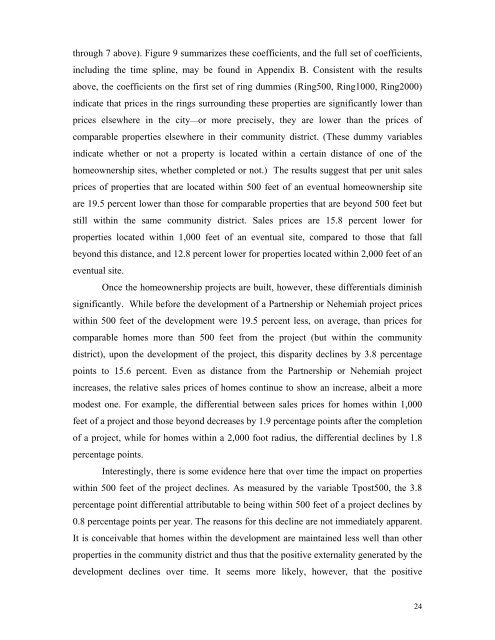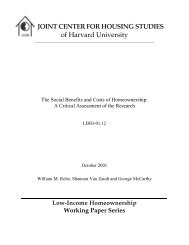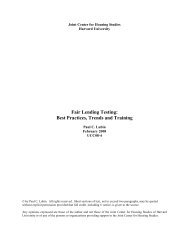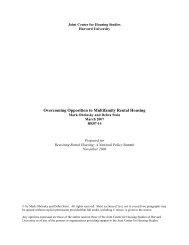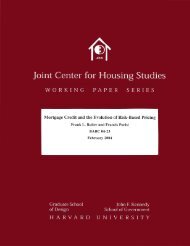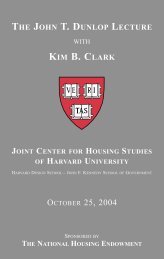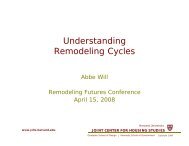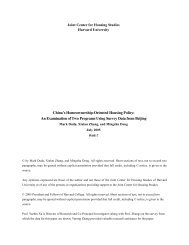please do not cite or circulate without permission of the authors
please do not cite or circulate without permission of the authors
please do not cite or circulate without permission of the authors
Create successful ePaper yourself
Turn your PDF publications into a flip-book with our unique Google optimized e-Paper software.
through 7 above). Figure 9 summarizes <strong>the</strong>se coefficients, and <strong>the</strong> full set <strong>of</strong> coefficients,<br />
including <strong>the</strong> time spline, may be found in Appendix B. Consistent with <strong>the</strong> results<br />
above, <strong>the</strong> coefficients on <strong>the</strong> first set <strong>of</strong> ring dummies (Ring500, Ring1000, Ring2000)<br />
indicate that prices in <strong>the</strong> rings surrounding <strong>the</strong>se properties are significantly lower than<br />
prices elsewhere in <strong>the</strong> city—<strong>or</strong> m<strong>or</strong>e precisely, <strong>the</strong>y are lower than <strong>the</strong> prices <strong>of</strong><br />
comparable properties elsewhere in <strong>the</strong>ir community district. (These dummy variables<br />
indicate whe<strong>the</strong>r <strong>or</strong> <strong>not</strong> a property is located within a certain distance <strong>of</strong> one <strong>of</strong> <strong>the</strong><br />
homeownership sites, whe<strong>the</strong>r completed <strong>or</strong> <strong>not</strong>.) The results suggest that per unit sales<br />
prices <strong>of</strong> properties that are located within 500 feet <strong>of</strong> an eventual homeownership site<br />
are 19.5 percent lower than those f<strong>or</strong> comparable properties that are beyond 500 feet but<br />
still within <strong>the</strong> same community district. Sales prices are 15.8 percent lower f<strong>or</strong><br />
properties located within 1,000 feet <strong>of</strong> an eventual site, compared to those that fall<br />
beyond this distance, and 12.8 percent lower f<strong>or</strong> properties located within 2,000 feet <strong>of</strong> an<br />
eventual site.<br />
Once <strong>the</strong> homeownership projects are built, however, <strong>the</strong>se differentials diminish<br />
significantly. While bef<strong>or</strong>e <strong>the</strong> development <strong>of</strong> a Partnership <strong>or</strong> Nehemiah project prices<br />
within 500 feet <strong>of</strong> <strong>the</strong> development were 19.5 percent less, on average, than prices f<strong>or</strong><br />
comparable homes m<strong>or</strong>e than 500 feet from <strong>the</strong> project (but within <strong>the</strong> community<br />
district), upon <strong>the</strong> development <strong>of</strong> <strong>the</strong> project, this disparity declines by 3.8 percentage<br />
points to 15.6 percent. Even as distance from <strong>the</strong> Partnership <strong>or</strong> Nehemiah project<br />
increases, <strong>the</strong> relative sales prices <strong>of</strong> homes continue to show an increase, albeit a m<strong>or</strong>e<br />
modest one. F<strong>or</strong> example, <strong>the</strong> differential between sales prices f<strong>or</strong> homes within 1,000<br />
feet <strong>of</strong> a project and those beyond decreases by 1.9 percentage points after <strong>the</strong> completion<br />
<strong>of</strong> a project, while f<strong>or</strong> homes within a 2,000 foot radius, <strong>the</strong> differential declines by 1.8<br />
percentage points.<br />
Interestingly, <strong>the</strong>re is some evidence here that over time <strong>the</strong> impact on properties<br />
within 500 feet <strong>of</strong> <strong>the</strong> project declines. As measured by <strong>the</strong> variable Tpost500, <strong>the</strong> 3.8<br />
percentage point differential attributable to being within 500 feet <strong>of</strong> a project declines by<br />
0.8 percentage points per year. The reasons f<strong>or</strong> this decline are <strong>not</strong> immediately apparent.<br />
It is conceivable that homes within <strong>the</strong> development are maintained less well than o<strong>the</strong>r<br />
properties in <strong>the</strong> community district and thus that <strong>the</strong> positive externality generated by <strong>the</strong><br />
development declines over time. It seems m<strong>or</strong>e likely, however, that <strong>the</strong> positive<br />
24


